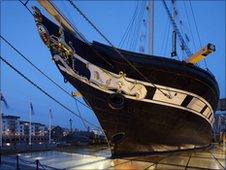SS Great Britain: From seabed to national treasure
- Published

Over five million people have toured the SS Great Britain since her return
After 37 years sitting on the seabed in the Falklands, the SS Great Britain was brought back home to Bristol in 1970. Exactly 40 years since its return, it has been restored to its former glory with a little help from the Duke of Edinburgh.
For the 100,000 people who lined the banks of the River Avon in Bristol on 5 July 1970, it must have been a strange sight.
There to welcome home one of the jewels of Britain's maritime history, the dark rusting hulk which slowly came into view must have seemed like a disappointment.
On that boat was the Duke of Edinburgh.
"There were a lot of people there, I think they were intrigued," he said.
"The story was fascinating. The dock they built her in was still there, untouched, after all that time. It was extraordinary. There was a real sense of occasion."
Like a mortally wounded warrior from the battlefield, the SS Great Britain limped home to her birthplace, a shadow of her former glory.
This was the culmination of a salvage operation which at times seemed futile.
The ship has now become a museum, with over 150,000 people visiting it each year.
The SS Great Britain was the world's first iron-hulled screw-driven ocean liner, propelled by a combination of steam and sail power and launched from Bristol in 1843.
She criss-crossed the Atlantic, made 32 runs to Australia with emigrants, served as a troop ship in the Crimean war and the Indian Mutiny, and later became a cargo ship.
The ship was eventually scuttled in the Falkland Islands in 1937 after 50 years as a storage hulk. It had been a sad end for a great ship.
Then came the daring rescue mission.
"She was a ship-shaped lump of iron, rust, and scrap," said Ivor Boyce, one of the tugboat skippers who gently towed her home.
He remembered telling his friends: "What are they going to do with her? No way can they make that into a viable ship anymore."
Many others though were swept away by the romance of the story. The daring rescue 8,000 miles from home, the near impossible task of raising Isambard Kingdom Brunel's great iron steam ship from the sea bed, the perilous journey across the Atlantic - all this stirred the hearts of Bristolians.
After all, they were welcoming home one of their own, 127 years after she was launched from the city.
"There was a sense of awe really," said Kim Hicks, who was 11 at the time.
"We had rose petals with us, picked from the garden, to scatter down on her as she passed."
Ms Hicks had a great vantage point. She was standing on another great Brunel creation - the Clifton Suspension Bridge.
She was there with her mother and her brother, and was struck by the enthusiasm of the crowd.
"There was a real buzz. We were waving union jacks and cheering. It was so exciting," she said.
Down on the river, Mr Boyce was taken aback by the reception.
"The crowds were absolutely phenomenal," he said.
"They were lining the banks, eight, 10, 12 deep. There were horns, hooters and all sorts. It was really noisy."
Huge crack
It was the end of a journey home that had been anything but uneventful.
After the ship had been raised from the seabed and brought to shore, the salvage team was faced with the rusting remains, peppered with holes and stripped of almost everything of any use.
A huge crack ran from top to bottom, which in places was a foot wide. The plan was to patch the holes, pump her out and float her sufficiently to manoeuvre a submersible pontoon underneath and then raise her out of the water for the long tow home across the Atlantic.
And, as Prince Philip said: "The idea of towing a ship on a platform up the Atlantic seemed to be me to be absolutely bloody lunacy. But there it is - it obviously worked."
There were many sticky moments, some of which called for inventive solutions. A huge mast snapped and came crashing down on to the deck almost causing disaster.
A frantic appeal had to be made on Falklands Radio for mattresses to stuff into the crack to make her watertight. It was an old naval technique dating back to Trafalgar, which worked.
"I can't begin to describe the feeling of intense excitement that everyone felt," said Malcolm Macleod, a captain in the Royal Marines in 1970 and part of the salvage team.
"Here we all were, 8,000 miles away from any support back home, using the wits of three or four quite brilliant people, with the ship coming up out of the water."
'Danger and suspense'
Standing on the top deck of the now fully restored ship, Rhian Tritton, of the SS Great Britain Trust, remembers the story of the rescue.
"It's a sort of Boy's Own story," she said.
"It's got everything - there's adventure, there's danger, there's suspense. There are so many points when it could have gone wrong and very nearly did.
"It's also got a sense of homecoming as well because the ship ended up back in the dock that she was built in, on the anniversary of the date she was launched."
Mr Macleod agreed. "The whole thing was so typically British, in the typically British understated way of doing business in those days," he said.
"To be honest it was bound to succeed."
Sunday's full report from Radio 4's Broadcasting House can be heard on iPlayer.
- Published4 July 2010